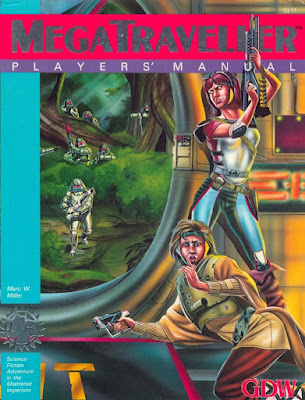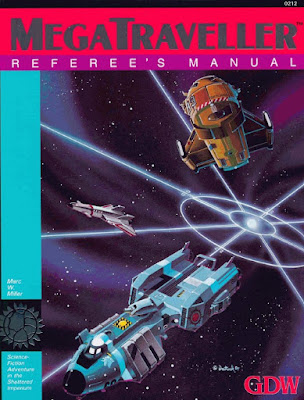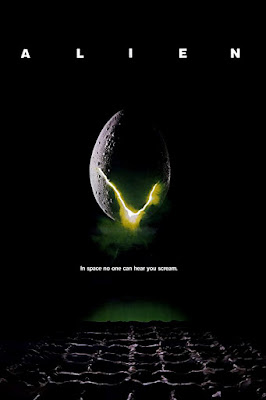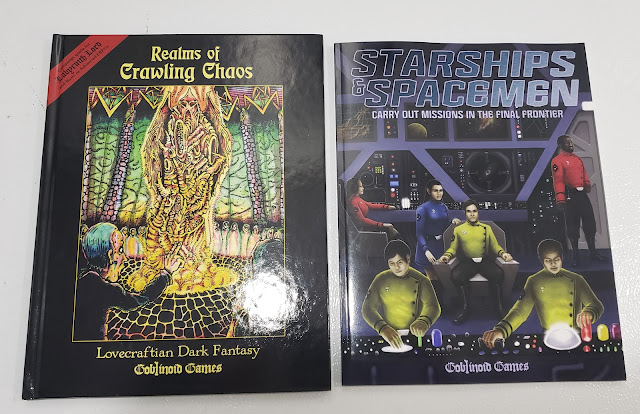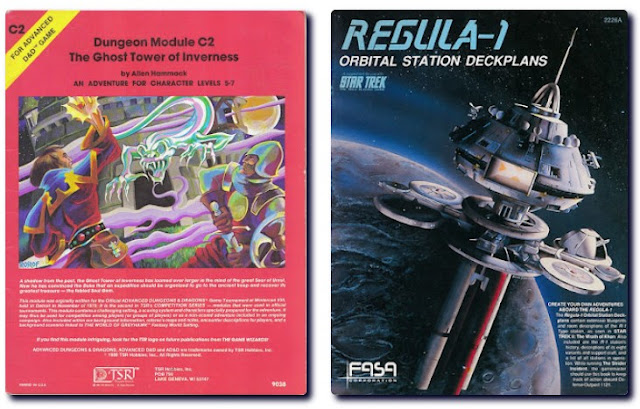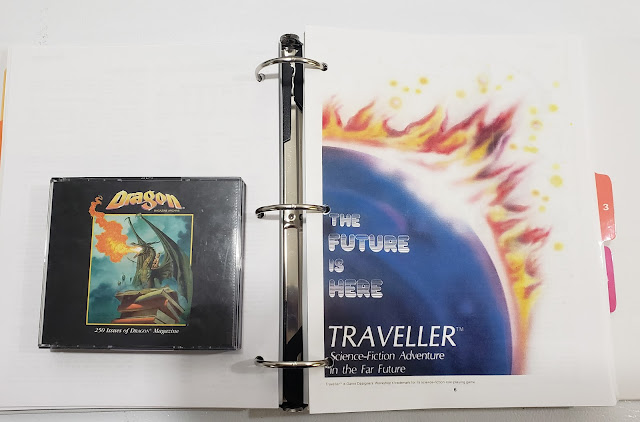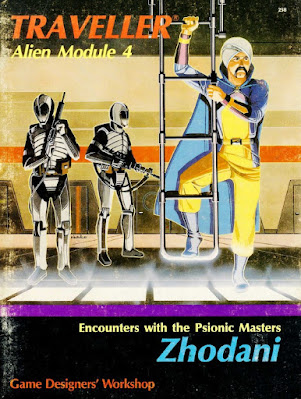It has, as far as I can tell, the least amount of supplements for its game line but that is not a huge surprise.
T4 Marc Miller's Traveller (1996)
PDF. 194 pages, color covers and color inserts, black & white art.
For the purposes of this review I am only considering the PDF from DriveThruRPR. There is a softcover POD that includes the color plates, but I do not have that.
There are a lot of familiar names here including Larry Elmore doing some of the interior art.
This game is set at the dawn of the Third Imperium, so in the opposite direction timewise the latest versions were going. It makes it pretty clear that setting wise at least is that this is not a sequel or continuation of MegaTraveller or Traveller: The New Era.
I will note I am not coming into this one blind. Even back then I had heard how this particular edition was riddled with errors and it there is a page (or two dozen pages) of errata out there. I am not going to consider that, nor do I even know if they are included in this file. I am going with no, but I'll check them out later.
Chapter 1: Roleplaying in the Traveller Universe
This is the typical "what is a role-playing game" and "what is Traveller" sections. It is all very similar to the Traveller Book.
Chapter 2: Character Generation
This feels an awful lot like Classic Traveller. In particular, again, the Traveller book. There are more careers here and you get more skills. It also doesn't look like you can die in character creation anymore, but you can be injured and discharged. You still go through background, homeworlds and advanced education, and more. Very familiar I am sure to the seasoned Traveller player. Speaking of familiar, our good friend Alexander Jamison is back. An error, on page 24 Ranks are mentioned (ok, cool same as CT), but in the tables on 29-32 have ranks of E1 to E9 and O1 to O10, Enlisted and Officer.
Chapter 3: Skills
For the first time, the skill list seems a bit smaller than in the last two editions. The chapter not huge and the skills are explained well.
Chapter 4: Task
This is a short and sweet chapter. Only 2 chapters. BUT a couple of things. First, we are now using a "Roll under" system which I am not a fan of. And there are all these "x.5" die rolls. I had forgotten about all the weird-ass die mechanics the late 90s flirted with. This is not the worse, but it is certainly no fun. I mean the task resolution is not terrible, but there are better ones. Much better ones.
Chapter 5: Ground Combat
This is a bit larger than tasks but still smaller than other versions. While there are changes due to the task resolution system it still reads a lot like Classic Traveller. In fact the range bands are now back!
Chapter 6: Equipment
The shopping chapter! One thing I notice is that computers (I know I harp on this, sorry it's my thing) seem to have really advanced. Though I have to point out the "advanced" computers of the Dawn of the Third Imperium are on par with the one I use now to write this. Minus the holographic display. But all in all a big improvement.
I am getting the feeling that somewhere between CT and T4 there is a great Traveller game.
What I am not getting yet is how the tech of this time differs from Classic Traveller's implied tech. This is supposed to be 1100 years before the LBBs.
Chapter 7: Surface Vehicle
This covers vehicles that are not starships. I do want to take a moment and comment on the improved art of this edition. Traveller never really had what I would call inspiring art. It had functional art and it had good descriptive art, but never anything like "wow that looks awesome." Some of the art here is of the awesome category.
Chapter 8: Spacecraft
One of my favorite chapters of past editions. Again starship computers are better handled. Creating a ship is a little like creating a character. There are even some nice photo-like pictures of starships. This section reads a bit differently than the others. Also the tables are organized by layout space rather than how they need to be consulted.
Chapter 9: Space Travel
Guess what is back? Yes! The equations! This whole section is very reminscent of the Classic Traveller books. Though I will admit I do not recall the grisly "Low Lottery" from previous editions. This isn't Star Trek folks.
Chapter 10: Space Combat
This chapter covers combat and it is a bit different. I'd like to say it looks faster, but I have not tried it out at all. Again I'll need to stat out a few ships and give them a trial run. Maybe I could run that Freetrader Beowulf rescue mission I have wanted to try.
Chapter 11: Psionics
Each edition Psionics gets a boost. The material here is again largely similar to Classic Traveller, but now there is a Psiconist service. That's new. I wonder if Babylon 5 was any influence here.
Chapter 12: World Generation
This is also a copy (more or less) from Classic Traveller. No world forms here though.
Chapter 13: Encounters
This is a combination of both the Encounters and Animal Encounters sections. This makes sense really. This is also all word for word from The Traveller Book. The more I red the more déjà vu I am getting.
I mean, can you tell which book these two sections are from. There is a small hint.
Now I am not complaining here. In 1996 when this came out the original Classic Traveller was 20 year old. The books were long out of print and GDW was gone. For someone who say played Traveller in High School, skipped all the other editions due to college and now was, oh I don't know, sitting on the train commuting from home to Chicago and back to home every day, this had to be a very welcome sight.
Chapter 14: Referee's Introduction
Our Game Master section. Not word for word from the Traveller book, but close enough. OR at least the feeling is the same. This does include some details on improving skills.
Chapter 15: Running Adventures and Campaigns
This is similar enough to the Traveller Book's "Referee's Guide to Adventuring." I am not sure is the authors (and there is plenty of evidence that there is more than one voice here) wanted to ignore everything after MegaTraveller OR were not allowed to use anything. I don't mean text I mean ideas. I think I wanted to see more here.
Chapter 16: Trade and Commerce
Again similar to other editions of Classic Traveller. Did text search and found it is largely the same text as Book 7, Merchant Prince. And again not a complaint here.
Chapter 17: Exit Visa (Adventure)
This is the same adventure from the Traveller Book.
Chapter 18: Rubicon Cross (Adventure)
This one is completely new as far a I can tell. In fact my online search for it pulled up references to T4 and the errata sheets. Guess I'll grab that.
Library Data and Index
The Library Data is pulled from Classic Traveller. Is it a copy? Yes. And sadly it preserved the focus on the current year being 1105 and Year 0. So the entries on "Dating Systems" and "Holiday Year" only make sense from a later perspective. Ok, I suppose it was possible that Cleon I proclaimed the current year as the Holiday year when he assumed power.
The Index is pretty good.
What do we know?
Well. Let's extend my D&D analogy here to the breaking point.
Original LBB Traveller is OD&D's LBB. I called the Traveller Book the "Holmes Basic" of Traveller, but in retrospect I think Moldvay Basic & Cook/Marsh Expert is a better fit. That makes Traveller Starter Edition the Mentzer BECMI D&D. Traveller 2300 is SPI's DragonQuest, Mega Traveller is AD&D 2nd Edition, and Traveller the New Era is 4th edition.
So what then in Marc Miller's Traveller? Since it is closest to the Classic Traveller line it is the 1991 Black Box or The Classic Dungeons & Dragons Game produced in 1994 and edited by Doug Stewart.
So who is Marc Miller's Traveller for?
In 1996 that answer was easy. It was for anyone that wanted to play Traveller that did not have access to the older Classic Traveller books and did not care for the New Era.
In 2022? Well. That is a harder one to answer. Today Classic Traveller is easily available in a variety of formats and editions. And I have not even started with Moongoose Traveller or the Cepheus Engine materials. IF there had been more material on the start of the 3rd Imperium here then that would give it a solid reason for setting alone. If the rules had been updated more with that 20 years of Traveller experience then that would have been a solid reason. Sadly neither of those are true enough. That added to the errors, the typos and some weird design choices make this a Traveller for the die hard fans only. That is NOT a bad thing. Just for my money I still prefer my Traveller Book.
Now what I might do, since I have the PDF and this is easy. Is go through it all and just print the updated sections I like and slot them into my Traveller 3-ring binder. I have a tab for "4" I could use AND I put in, or pencil in, all the errata I want or need.
I do want to point out again that the art in this book is phenomenal. There are some seriously good pieces that look like they come right off the cover of some great sci-fi novel. I like to think that was the intent. I am sure it makes for a gorgeous PoD book.







